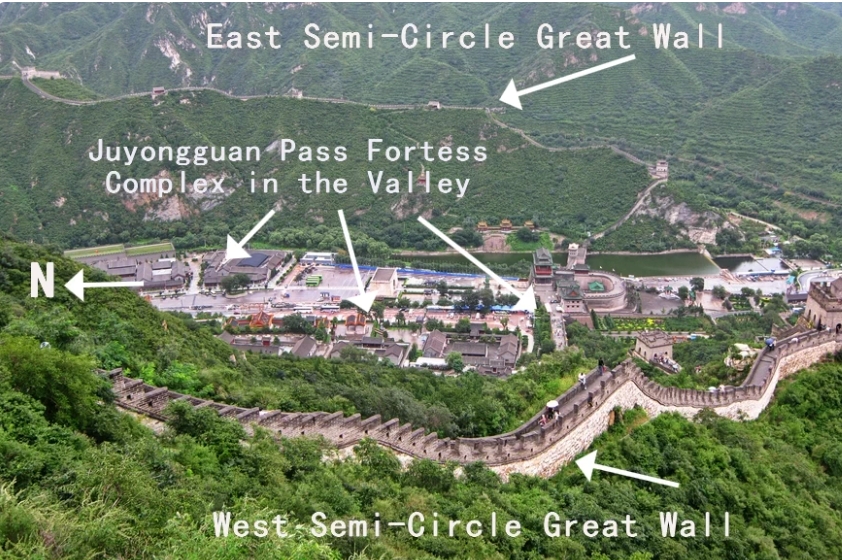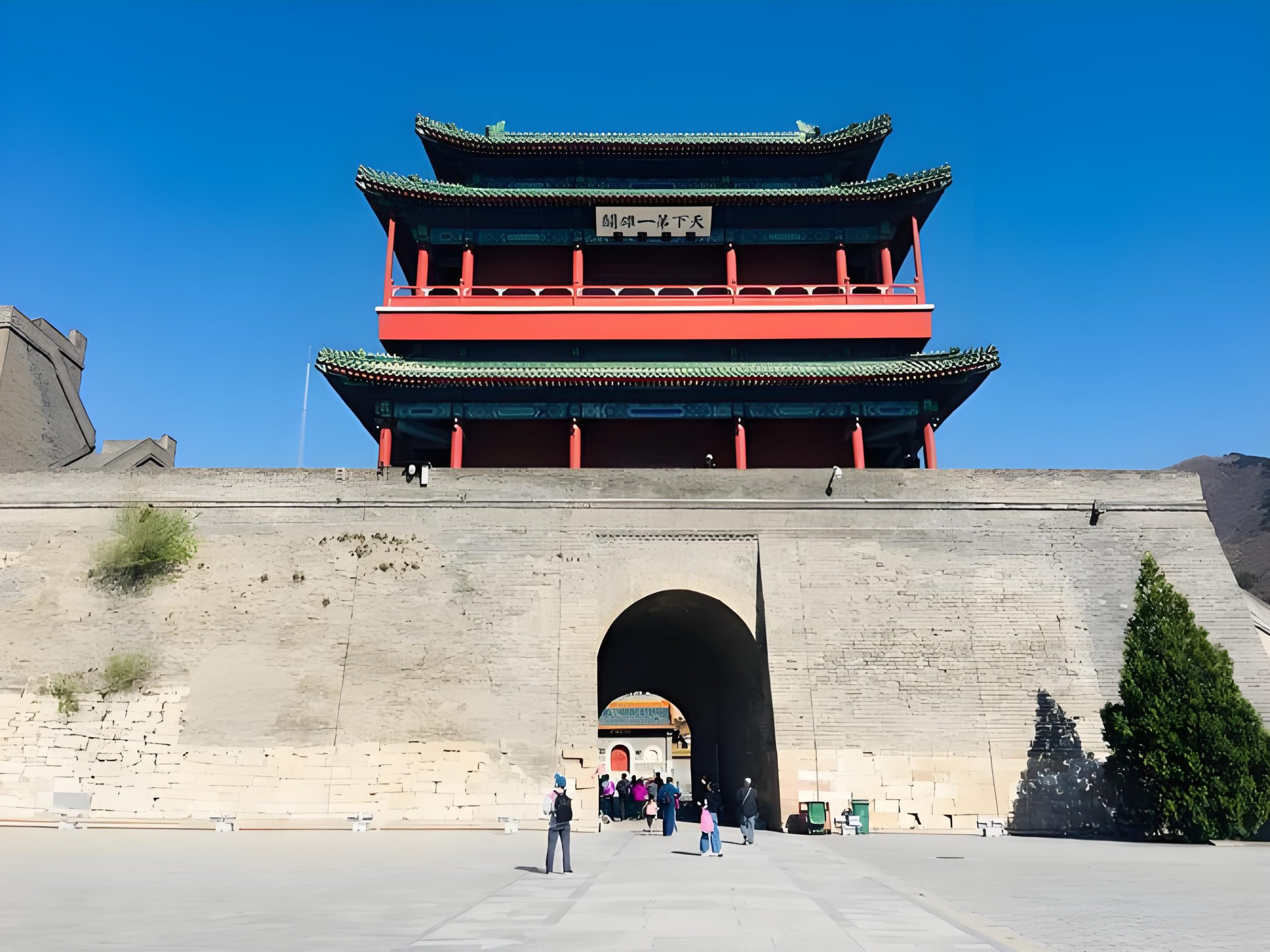1,Transportation:

Juyongguan Great Wall Google Map Location
-
Route of Bus No. 919: Jishuitan Station – Yanqing Stadium Community Station (one way). Get off at Juyongguan Great Wall Station. Note that it is the slow regular Bus No. 919, not the express Bus No. 919. (For the return trip, take Bus No. 20 from Parking Lot No. 3. The last bus is at 17:30).
-
Route of Bus No. Chang 20: Shahe Station – Juyongguan Great Wall Station (round trip).
-
Route of Bus No. 879: Dingling Station – Badaling Great Wall Station (round trip). Get off at Juyongguan Village Station.
2,Latest business hours of Juyongguan Great Wall Scenic Area
2,From October 8 of each year to March 15 of the following year:
3,Route introduction of Juyongguan Great Wall

Map of Juyongguan Great Wall
Route introduction:
1️⃣East line: About 1 hour.
Shorter and flatter than the west mountain line. Moreover, on the east line, you can see the “Flower Sea Train”, which is suitable for friends who don’t want too much exercise. However, the area from Shuimen Gate Tower to Tower No. 4 on the east line is not open. So you can only climb three or four towers and then return the same way.
2️⃣West line: 2 – 3 hours.
Long and relatively steep. The mountain scenery is more majestic. There is Tower No. 12, the highest peak. Suitable for young people with good physical strength. It should be noted that the steepest slope can be sixty or seventy degrees. Looking down from above is still quite frightening. Those with acrophobia should choose carefully!!
3️⃣Loop line: 3 – 4 hours.
If you have good physical strength and sufficient time, you can experience the loop line. It is recommended to climb the east line first and then the west line. Focus your energy on the west line. Because if you climb the west line first, you may not have the physical strength to go to the east line anymore.

Tourist routes of Juyongguan Great Wall
Recommended tourist routes:
1️⃣Easy tour route: Scenic area entrance – Begonia Flower Stream – Cloud Platform – South and North Arch City.
This route is relatively flat and suitable for the elderly and children.
This route can capture the magnificent scenery of the Great Wall and the flower sea in spring. It is very suitable for photography enthusiasts.
3️⃣Challenging climbing route: Scenic area entrance – Great Wall footpath – Climb to the highest point of the Great Wall – Walk along the Great Wall to the next beacon tower. This route is relatively steep and suitable for tourists with abundant energy. You can experience the fun of climbing the Great Wall.
4️⃣In-depth cultural route: Scenic area entrance – Juyongguan Museum – Visit historical sites – Walk along the city wall. This route can help you deeply understand the history and culture of Juyongguan.
‼️Difference from Badaling Great Wall
The main sections of the Great Wall in Beijing are mainly Badaling and Juyongguan. The main differences are: Badaling has more people and cableways, and it is farther from the urban area.Juyongguan has relatively fewer people and is closer to the urban area, but there is no cableway and you can only climb.
So for those with poor physical strength who don’t want to climb mountains, it is still recommended to choose Badaling Great Wall.
4,Introduction and historical culture of Juyongguan Great Wall
1,Juyongguan is the gateway to enter Beijing from the north. It is an important barrier on the north side of the capital. The situation is dangerous. It has the momentum of “one man guards the pass, ten thousand men cannot open it”. It is one of the “nine passes in the world” in ancient times.

Juyongguan Great Wall
2,The south gate tower of the pass city is the landmark building of Juyongguan, known as “the first pass under heaven”. The city tower connects the winding city walls on the east and west ridges. The total length is 4,142 meters. Standing on the city tower of Juyongguan and looking around, one can see the importance of the Juyongguan fortress in the past.

The south gate tower of the pass city, known as “the first pass under heaven”
3,In front of the south gate of the pass city, there is a “Ying’en Square” specially built to welcome the emperor.

“Ying’en Square” for welcoming the emperor
4,After entering the city through the south gate tower of the first pass, the first thing one sees is the “Guoji Square”.

Guoji Square
5,In the center of Juyongguan, there is a base of an overpass tower, named Cloud Platform. It is named so because it looks like it is in the clouds from a distance. Under it passes a trapezoidal round arch passage.

Cloud Platform,
6,The stone walls inside and outside the archway of the Cloud Platform are carved with various exquisite Buddhist statues with vivid postures. The stone walls are carved with statues of the Four Heavenly Kings with vivid postures. The carving skills are superb. It can be called a masterpiece in Chinese architectural art. There are many stone Buddha statues carved on the stone walls of the archway.

Stone walls inside and outside the archway of the Cloud Platform

Statues of the Four Heavenly Kings

Stone Buddha statues
7,Outside the south gate tower of Nanguan is the barbican. Inside the barbican, there is a Guandi Temple, blessing the pass city and bringing blessings to the country and the people. Inside and outside the pass city are distributed various related facilities such as government offices, temples, and Confucian schools. Looking from the east mountain, the tall and majestic pass tower and the continuous battlements can be seen in full view.

Barbican
8,The Shuiguan was formed when the pass city was expanded and reinforced and two gates for land and water were set up during the Jingtai period.

Shuiguan
9,In history, the magnificent Juyongguan was said to be one of the “eight scenic spots of Yanjing”. On the mountain are enemy platforms and beacons. At the foot of the mountain is the Horse God Temple.

Horse God Temple
10,The Chenghuang Temple in the pass city was built during the Hongwu period of the Ming Dynasty (1368 – 1397). In ancient China, a moat with water was called “pool”, and a moat without water was called “city god moat”. The city god then became the god protecting the city.

Chenghuang Temple in the pass city
11,The picture shows the granary of Longqing Left Guard, the garrison troops of Juyongguan at that time. Fengyu Granary was built in the first year of Yongle in the Ming Dynasty (1403 AD). In addition, there is one Yongfeng Granary and three round granaries.

Ancient granary
12,There is a tower on each side of the tall and majestic city tower in the north and south. They are triple-eaved hip-roofed with green glazed tiles trimmed on the edges. They are 21 meters high. The city platform below is 10 meters high. The city tower is the center for commanding operations (north city tower).

North city tower, the center for ancient command operations
13,The Zhenwu Temple in the north barbican, built in 1425, enshrines the main god Zhenwu Emperor. Zhenwu is also known as Xuanwu. He is the god of the north in ancient Chinese mythology.

Zhenwu Temple in the north barbican
14,The 78-year-old Wang Xiuqi is a “retired” old man in Juyongguan Village. His ancestors moved from Hongtong County. He was the defender of Juyongguan. After “retirement”, he opened a small store at the entrance of the village.

“Defender of Juyongguan”